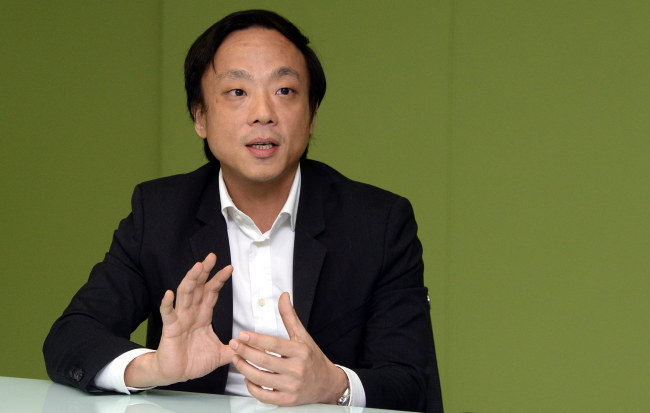[Design Forum] Removing the unnecessary brings out the essence of design: architect
By Korea HeraldPublished : Nov. 5, 2014 - 21:08
This is the third in a weekly series that examines the expanding role of design in the run-up to the Herald Design Forum 2014 on Nov. 26. ― Ed.
“Less is more.”
Joon Paik’s simple answer epitomizes what he puts above all else in architectural design.
“It’s actually easy to add things. But if you keep adding, you end up with just a mixture of everything with no clear point,” said Paik, vice president of Seoul-based Chang-jo Architects.
“The essence of a design unveils itself when unnecessary bits are removed with confidence in order to express one’s initial motive.”
“Less is more.”
Joon Paik’s simple answer epitomizes what he puts above all else in architectural design.
“It’s actually easy to add things. But if you keep adding, you end up with just a mixture of everything with no clear point,” said Paik, vice president of Seoul-based Chang-jo Architects.
“The essence of a design unveils itself when unnecessary bits are removed with confidence in order to express one’s initial motive.”

Paik believes that the process of expressing the gist of an architectural design is basically the same as producing a film or a sculpture or a well-edited article.
Like cutting and polishing a rough diamond, building a structure is also about “removing” to win people’s hearts and to make it fit in with the surrounding environment, he said.
The architect stressed that “time,” or waiting and making effort, was also crucial.
“A good architectural design is never achieved overnight,” he said.
“It requires taking out the unnecessary and polishing (one’s ideas) over a long period of time.”
Paik’s design philosophy was shaped as he built up a glamorous career over many years.
Paik moved to the United States at age 15 and studied architecture at the Rhode Island School of Design and Harvard University Graduate School of Design.
After finishing his master’s program, he worked at the design office of world-renowned architect Renzo Piano and then took part in major projects at Foster + Partners from 2000 through last year.
While working at the firm, set up by British architect Norman Foster, Paik led the design of Spaceport America, the world’s first commercial spaceport in New Mexico.
After over 20 years abroad, Paik, a member of the Royal Institute of British Architects, returned home in 2012 to join Chang-jo Architects.
Last year, he led the design of the Mobility Lounge, an exclusive showroom for the BMW 7 Series, which was well received for its unique assembly of wooden blocks that created a curvy, canyon-shaped wall.
What Paik feels is most vital in the Korean architectural scene is “openness.”
“Leonardo da Vinci and Michelangelo could create works of a century because they had the Medici family who gave them the freedom to be imaginative while sponsoring them financially,” he said.
“If the companies that commission work to Korean architects provide them with the liberty to demonstrate their creativity to the utmost as long as they meet the companies’ core brand values, I believe we will see an upgrade in (Korean) architectural design.”
Paik noted that there seems to be widespread imitation of anything foreign even in architectural design.
“There are many things to learn from advanced nations, but it is also very important to find the strengths and character that is Korean,” he said.
Paik underlined sustainability as a key value, noting that architecture with a lack of consideration for sustainability will naturally lose ground.
“Ways to save energy and use more renewable energy are already widely discussed in the reviewing stages of construction plans,” he said.
“But it has been only about 20 to 30 years since the use of renewable energy or reuse of gray water was introduced to architectural design, and they cost a lot. Minimizing the gap between sustainability and efficiency, or cost, is the biggest task architectural design faces today.”
At the moment, Paik is captivated by carbon fiber.
Carbon fiber has 10 times the intensity of steel-frame structures used in buildings while having only about a quarter of the weight, helping reduce transport expenses.
Ethylene tetrafluoroethylene, a fluorine-based plastic known as ETFE, which can replace heavy and fragile glass, also fascinates the architect.
In addition to the long-term goal of achieving both sustainability and cost efficiency, Paik likes to think about how to raise the quality of life through changes in everyday spaces ― for example, an office space.
“You don’t come up with creative ideas by racking your brains in the same desk all the time. New ideas often come when you change spaces and views, feel different things in different spaces,” he said.
“Instead of offices with dull, straight-lined designs, I’d like to create dynamic lounges with curvy tables and sofas for work space.”
By Shin Dong-yoon and Kim So-hyun
(realbighead@heraldcorp.com)
-
Articles by Korea Herald








![[Graphic News] More Koreans say they plan long-distance trips this year](http://res.heraldm.com/phpwas/restmb_idxmake.php?idx=644&simg=/content/image/2024/04/17/20240417050828_0.gif&u=)
![[KH Explains] Hyundai's full hybrid edge to pay off amid slow transition to pure EVs](http://res.heraldm.com/phpwas/restmb_idxmake.php?idx=644&simg=/content/image/2024/04/18/20240418050645_0.jpg&u=20240419100350)






![[From the Scene] Monks, Buddhists hail return of remains of Buddhas](http://res.heraldm.com/phpwas/restmb_idxmake.php?idx=652&simg=/content/image/2024/04/19/20240419050617_0.jpg&u=20240419175937)

![[KH Explains] Hyundai's full hybrid edge to pay off amid slow transition to pure EVs](http://res.heraldm.com/phpwas/restmb_idxmake.php?idx=652&simg=/content/image/2024/04/18/20240418050645_0.jpg&u=20240419100350)

![[Today’s K-pop] Illit drops debut single remix](http://res.heraldm.com/phpwas/restmb_idxmake.php?idx=642&simg=/content/image/2024/04/19/20240419050612_0.jpg&u=)